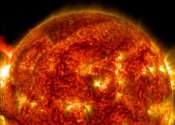Large coronal hole near the sun's north pole
The European Space Agency/NASA Solar and Heliospheric Observatory, or SOHO, captured this image of a gigantic coronal hole hovering over the sun's north pole on July 18, 2013, at 9:06 a.m. EDT. Coronal holes are dark, low ...








